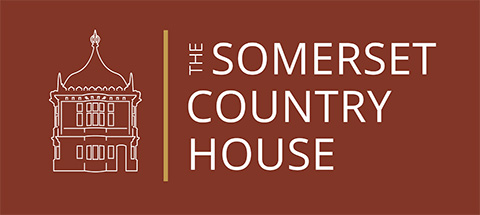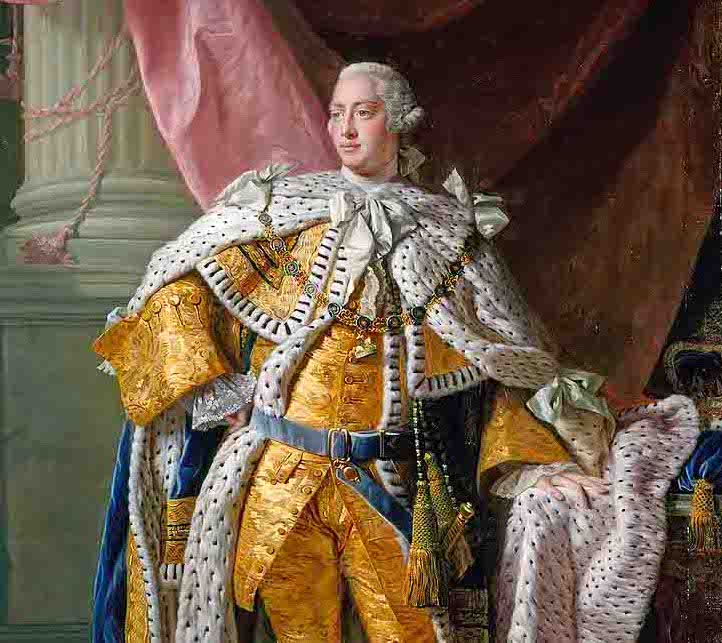Main Photo Source: ‘George III (1738-1820)’ by Allan Ramsay (1713-1784), c. 1761-62. Source: Wikimedia Commons.[i]
The coronation of George III and Queen Charlotte took place on Tuesday 22nd of September 1761. It was nothing like the well planned and executed coronation of Charles III and Camilla in 2023. In 1761 the coronation was chaotic. Besides the crowds and carriages that descended on the city, the sword of state had been forgotten as well as no chairs or canopy for the king and queen.[ii] The procession set forth from Westminster Hall, through New Palace Yard, Parliament Street, Bridge Street and King Street to the west door of the Abbey. The procession was a huge draw and people watched from the pavement, houses, roofs, and purpose-built wooden viewing platforms.[iii]
Edward Phelips V of Montacute House did not attend the coronation. He just went about his business as usual. He hunted and dined with local gentry. He seemed more interested in the birth of Lady Augusta Fane at Brympton House near Yeovil than what was happening in London. He doesn’t make it clear as to why he didn’t accompany his wife. He doesn’t state where she stayed. However, in other diaries he mentions lodgings in Parliament Street. It is possible his wife, and her companion to the event, Miss Woodford, stayed there and would have had a probable good view of the procession as it went by their lodgings.
Edward’s diary entry for: Friday 18th September 1761[iv]
‘Went hunting. Mr Fane’s Hounds. Killed 4 Hares. Came Home to Dinner’
‘Mrs Fane brought to Bed of a Daughter 20 Minutes Past 9 in the Morn’
‘Lady Augusta Fane born’
Saturday 19th September 1761[v]
‘Went to Leweston to Dinner found Daubeny & Birch. Went Even & Lay there’
‘My Wife & Miss Woodford set out for the Coronation’
Edward had married Maria Wright (1730 – 1793) in 1747. Their first surviving six children were born between 1750 and 1759. Maria would not have another child until 1765. Between 1759 and 1764 appears to have been a pregnancy-free period of five years. Although miscarriages were not likely to be something Edward would mention. The trip to London to see the coronation must have been a welcome excursion after producing children every couple of years.
From the diary entries Edward appears to have been unmoved by the coronation. Just noting that his wife and Miss Woodford had set out for it. Mrs. Phelips and Miss Woodford left on Saturday 19th of September, with the Coronation taking place Tuesday. It possibly took them Saturday, Sunday, and Monday to travel to London. The coach trip to London took at least two days from Somerset. It is probable that they took the coach that Edward owned. Changes of horse would have been required along the route.
From what I can ascertain in the diary entries for September 1761, whilst Edward’s wife was in London, he continued a daily ritual of hunting and dining at various local gentlemens’ residences – e.g., Mr. Waters (?), Barlett’s, and Cox’s. Daubeny dined with him at Montacute. There was the Norton Feast on Monday 21st of September, and Chinnock Feast on Tuesday 22nd of September. Further diary entries the time state:
Sunday 20th September 1761[vi]
‘Dined at Leweston & returned home in the Even’
Sunday 27th September 1761[vii]
‘Dined at Waters Daubeny returned evening My Wife returned.’
Notes on Leweston Manor
Leweston Manor is nowadays a school. It is situated near Sherborne in Dorset. In the late 17th C Leweston it was owned by Sir George Strode of Parnham. He died in 1701, leaving a set of complex terms in his will. However, it eventually went to Francis Greville, 1st Earl Brooke. Greville had Warwick Castle as his seat and sold Leweston to Stephen Naish of Bristol. Naish’s daughter married William Gordon (d. 1802). William Gordon pulled it down circa 1795 and built the Georgian house.[viii]
The manor that was familiar to Edward Phelips would have been the ancient seat of the Lewston family, who had the manor since 1346. The last Lewston was John, who died in 1584. Their male line died out in 1584 and it passed to a John Fitzjames, the son of John Lewston’s second wife by a previous marriage.[ix]
John Hutchins wrote in Volume IV of the History of Dorset:
‘John Lewston, the last of this family, dying without issue male, gave this estate to John Fitzjames, the son of his second lady by her first husband Aldred Fitzjames. This ancient family was formerly seated at Redlinch.’[x]
‘Here was a large old house, the ancient seat of the Lewstons, much beautified, as Mr. Coker says, by Sir John Fitzjames.’[xi]
It maybe that the French master mason Allen Maynard (d. 1598) had been involved in this ‘beautification’ of the medieval house. It has been suggested that Maynard may have been responsible for the tomb monument at Sherborne Abbey to John Lewston and his wife, which Fitzjames possibly paid for.[xii]
Hutchins remarks:
‘The noble mansion at Leweston has been, to the regret of many admirers of ancient grandeur entirely pulled down ; and upon the site of it a very elegant modern house was erected by William Gordon, esq. who possessed the Leweston estate through his marriage with the sister and heiress of the late Sir Stephen Naish, knt. of the city of Bristol, and of this place, which was purchased of Lord Brooke by him or his father, ….. Naish, esq. an eminent Bristol merchant. Mr. Gordon died at Bristol 1802, and was buried in the chapel at Lewston[xiii]. (His lady married, secondly, John Berkeley Burland, esq. of Stock Gaylard…).’[xiv]
BIBLIOGRAPHY
Hutchins, John, The History And Antiquities of the County of Dorset, 3rd edn, 4 vols (London: John Bowyer Nichols, 1870)
Strong, Roy, Coronation: A History of the British Monarchy, (London: WilliamCollins, 2022)
NOTES
[i] ‘George III (1738-1820)’ by Allan Ramsay (1713-1784), c. 1761-62, Royal Collection, Wikimedia Commons, https://commons.wikimedia.org/wiki/File:Allan_Ramsay_(1713-84)_-_George_III_(1738-1820)_-_RCIN_405307_-_Royal_Collection.jpg [accessed 12 August 2023].
[ii] Roy Strong, Coronation: A History of the British Monarchy, (London: WilliamCollins, 2022), p. 304.
[iii] Strong, pp. 304-305.
[iv] Somerset Heritage Centre, ‘Edward Phelips. 1761-1781’, Phelips Manuscripts, DD/PH/183.
[v] Phelips Manuscripts, DD/PH/183.
[vi] Phelips Manuscripts, DD/PH/183.
[vii] Phelips Manuscripts, DD/PH/183.
[viii] Roger White, ‘Leweston Manor: The uniquely charming house where Georgian architecture meets Art Deco interiors’, (Country Life, 2020), https://www.countrylife.co.uk/architecture/leweston-manor-uniquely-charming-house-georgian-architecture-meets-art-deco-interiors-209789 [accessed 7 August 2023].
[ix] White, ‘Leweston Manor’.
[x] John Hutchins, The History And Antiquities of the County of Dorset, 3rd edn, 4 vols (London: John Bowyer Nichols, 1870), IV, p. 128.
[xi] Hutchins, The History And Antiquities of the County of Dorset, IV, p. 131.
[xii] White, ‘Leweston Manor’.
[xiii] Note that ‘Leweston’ and ‘Lewston’ are interchangeable by Hutchins. I had perhaps thought that the manor is Leweston, and the family name Lewston.
[xiv] Hutchins, The History And Antiquities of the County of Dorset, IV, p. 132.

